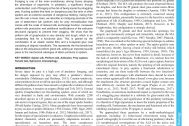Content
Foraging is one of the main evolutionary driving forces shaping the phenotype of organisms. In predators, a significant, though understudied, cost of foraging is the risk of being injured by struggling prey. Hunting spiders that feed on dangerous prey like ants or other spiders are an extreme example of dangerous feeding, risking their own life over a meal. Here, we describe an intriguing example of the use of attachment silk (piriform silk) for prey immobilization that comes with the costs of reduced silk anchorage function, increased piriform silk production and additional modifications of the extrusion structures (spigots) to prevent their clogging. We show that the piriform silk of gnaphosids is very stretchy and tough, which is an outstanding feat for a functional glue. This is gained by the combination of an elastic central fibre and a bi-layered glue coat consisting of aligned nanofibrils. This represents the first tensile test data on the ubiquitous piriform gland silk, adding an important puzzle piece to the mechanical catalogue of silken products in spiders.



